Murinae
The Old World rats and mice (called Murinae) is a subfamily in the family Muridae. It has about 560 species. This subfamily is larger than all mammal families except the Cricetidae. It is also larger than most mammal orders.
| Murinae Temporal range: Middle Miocene – Recent
| |
|---|---|

| |
| Mus musculus, the house mouse | |
| Scientific classification | |
| Domain: | Eukaryota |
| Kingdom: | Animalia |
| Phylum: | Chordata |
| Class: | Mammalia |
| Order: | Rodentia |
| Family: | Muridae |
| Subfamily: | Murinae Illiger, 1811 |
Description change
The Murinae are native to Africa, Europe, Asia, and Australia. They are the only terrestrial placental mammals native to Australia. They have also been introduced to all continents except Antarctica. They are serious pest animals. This is particularly true in islands where they have endangered and caused the extinction extinction of many native animals.
The brown rat and the house mouse are both used for medical tests. They are among the animals whose genome has been sequenced.
The murines have a distinctive molar pattern that involves three rows of cusps instead of two, the primitive pattern seen most frequently in muroid rodents.
Fossils change
The first known appearance of the Murinae in the fossil record is about 14 million years ago with the fossil genus Antemus. Progonomys is thought to be the ancestor of Mus and relatives, while Karnimata is thought to lead to Rattus and relatives. All of these fossils are found in the well-preserved and easily dated Siwalik fossil beds of Pakistan.
The genera Uranomys, Lophuromys, and Acomys were once thought to be murines. Later, it was discovered (by molecular phylogenetics that they were more closely related to gerbils. They have been assigned a new subfamily status, the Deomyinae.
Sources and further reading change
- Chevret P. et al 1993. Molecular evidence that the spiny mouse (Acomys) is more closely related to gerbils (Gerbillinae) than to the true mice (Murinae). Proceedings of the National Academy of Sciences USA, 90:3433-3436.
- Jacobs L.L. 1978. Fossil rodents (Rhizomyidae and Muridae) from Neogene Siwalik deposits, Pakistan. Bulletin of the Museum of Northern Arizona, 52: 1-103.
- Jansa S.A. and M. Weksler. Phylogeny of muroid rodents: relationships within and among major lineages as determined by IRBP gene sequences. Molecular Phylogenetics and Evolution, 31:256-276.
- Michaux J. A. Reyes and F. Catzeflis 2001. Evolutionary history of the most speciose mammals: molecular phylogeny of muroid rodents. Molecular Biology and Evolution, 17:280-293.
- Nowak, R.M. 1999. Walker's Mammals of the World, vol. 2. Johns Hopkins University Press, London.
- Steppan S.J; R.A. Adkins and J. Anderson 2004. Phylogeny and divergence date estimates of rapid radiations in muroid rodents based on multiple nuclear genes. Systematic Biology, 53:533-553.